How To Improve Your Pet’s Dental Care At Home
Our pet’s dental care needs to be a top priority because just like us, poor dental hygiene can lead to disease and ill-health.
Over 85% of dogs and 70% of cats from the age of 3 years suffer from dental disease.
We can prevent this by utilising at-home teeth cleaning methods and having regular professional dental examinations performed by our vets.
In this article, we focus on what you can do at home to help keep your dog and cat’s mouth and teeth clean and healthy.
How To Decide If Our Cat Or Dog Needs A Dental?
Before we discuss what you can do at home, watch this quick video where Dr Leigh explains how you can tell if your pet needs dental treatment at the vet.
All our pets will require their teeth to be professionally cleaned by a veterinarian at some stage of their life.
The timing of when this starts is very dependent on the preventative work you do as an owner at home and the individual’s mouth.
Some pets are more prone to dental disease than others, for example, brachycephalic breeds often suffer from poor dental health purely due to lack of space in the mouth.
While many cats get painful absorptive lesions as they get older that are missed without a proper vet examination under anaesthesia.
As a rule of thumb cats and dogs require a veterinary dental exam, scale and polish from about 2 years old and then repeated every 6 to 18months as required.
Again, there are no rules. Just like us, our pets are individuals.
However, it is worthwhile having your vet check your pet’s mouth every 6 months.
Remember that a professional veterinary scale and polish needs to be performed under anaesthesia for the whole mouth to be assessed and cleaned properly.
The current trend of non-anaesthesia dentistry is a very big concern for animal welfare.
For more detailed information on why vets do not recommend anaesthesia-free dentistry please read this article: Why anaesthesia free dentistry for dogs and cats is not recommended by vets & welfare advocates.
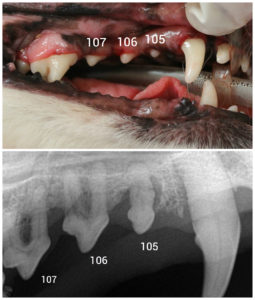
Only radiographs could identify the periodontal disease and bone loss affecting this dog’s teeth. We perform dental charting and did not find any pocketing or mobility associated with 105-107, yet all three needed to be extracted due to >50% bone loss affecting each. Photo credit Mariposa Veterinary Wellness Centre.
Pet Teeth Cleaning You Can Perform At Home
All vets will recommend that you try to clean your cat or dog’s teeth with some sort of toothbrush.
It doesn’t matter what diet your pet is on, tartar and plaque will build up and manual removal by brushing will help prevent gingivitis and periodontitis.
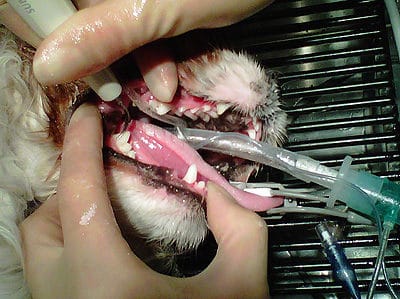
A veterinarian probes the gum sulci checking for a pocket that indicates periodontitis.
Begin brushing teeth when you get your pet as a puppy or kitten.
Otherwise, it’s never too late to start brushing, it just may take a little longer for them to get used to it!
Many cats and dogs find this a little confronting and we don’t want to scare them, but they soon learn that it is nothing to be scared of.
You can start with finger brushing and slowly advance to using a small toothbrush.
It is best to use special pet toothpaste. Definitely, don’t use a human brand toothpaste as this has too much ‘frothing’ and fluoride.
Ideally, just like us, our pets benefit from at least once per day brushing. But hey, we understand that life gets in the way.
If you can brush your pet’s teeth a minimum of 3 times per week, that will go a long way to preventing dental disease.
Should I Give My Pet Dental Chews?
There are many dental chews on the market; dog dental chews and cat dental chews.
Choosing a type of dental chew can be confronting!
Dental chews and sticks are a great way to help keep your pet’s gums and teeth healthy, especially on days when you can’t physically brush their teeth.
When trying to work out what type of dental stick we want to feed our cat or dog we need to determine what the purpose is and make sure we use a product with a good safety profile.
The Veterinary Oral Health Council has a seal of approval system for dental chews where the product must meet VOHC’s Standards for effectiveness in retarding plaque and tartar when used as directed. You can check whether your product of choice is listed on the VOHC website.
The most important thing to remember with a dental chew is that your dog or cat chews the product and doesn’t gulp it down with one bite. This can cause two problems: obstruction or it just doesn’t do the intended job.
For this reason, we recommend always observing your dog or cat when they are eating a dental chew or stick.
The ingredients of the chews are designed to be activated by the chewing action, so the more chewing that occurs the better. This may mean you have to hold onto the chew while your dog or cat chews at one end!
Remember that some dental chews (just like any new food), may cause a stomach upset leading to vomiting or diarrhoea in the individual animal. It is best to use these as per package directions and stop if any ill health occurs.
What Is The Best Dental Diet For My Pet?
Some types of kibble are specially formulated to help clean tartar from our pet’s teeth. This is a great option to use in conjunction with the normal diet we give our pets.
The best dental diets are prescription-only diets, so please consult your veterinarian as they will be unsuitable for some pets due to some of the ingredients.
You can contact our online vets if you would like some help to decide if this is an option for your pets.
How Do Dental Diets Work?
Most dental kibble diets work via two types of action:
- Mechanical: a larger kibble size means that there is more surface area for the teeth to work over as well as resistance to breakage. This provides a ‘brush-like’ effect.
- Chemical: some will contain calcium chelation agents to chemically reduce tartar formation as well as special anti-bacterial properties to prevent bad breath.
The benefits of a dental diet are that it helps to prevent plaque buildup daily.
Remember that other foods can also help your dog or cat’s teeth.
The best dog food for teeth can be a special kibble as above or you may like to try feeding your dog a bone. Please remember the rules of bone feeding: big, raw and never cut. To find out more on How to feed bones safely to your dog in this article.
You can also feed chicken necks to cats although we prefer not to feed these to dogs for two reasons:
1. they don’t offer enough mechanical action to have an effect and
2. there have been cases of polyradiculitis associated with raw chicken necks in dogs.
The best cat food for teeth is again a prescription kibble or I do like to give the occasional long strip of cooked beef for them to chew.
Gravy beef is a good option for this.
Cut a piece about 7mm thick and 10cm long, cook in the frying pan and give it to puss once it’s cold.
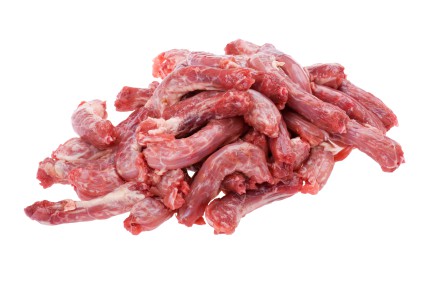
Raw chicken necks are not useful for cleaning teeth as the bone is too soft and most dogs don’t chew. Cats may benefit.
What Is The Best Way To Keep My Pet’s Teeth Clean?
In summary, the best way to keep your pet’s teeth clean, breath fresh and body healthy is for you to provide:
- Regular dental checkups with your vet (6monthly) and a scale and polish as required.
- Feed a kibble designed for keeping dental tartar and plaque in check.
- Brush teeth daily if possible, and at least 3 days per week.
- Use dental chews daily if you can’t brush your pet’s teeth.
Tutorial: Dr Leigh Explains Home Dental Care
Tell us below how you keep your pet’s teeth and gums healthy? What works best for you?

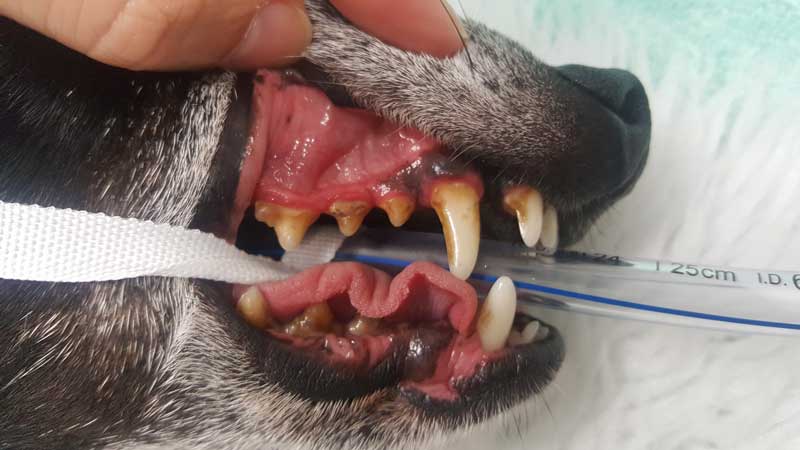
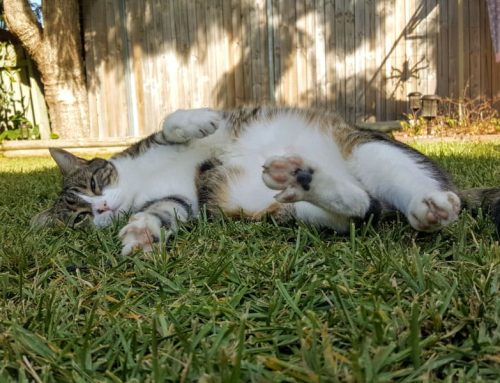
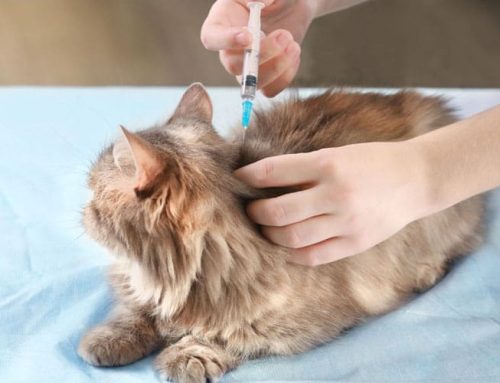
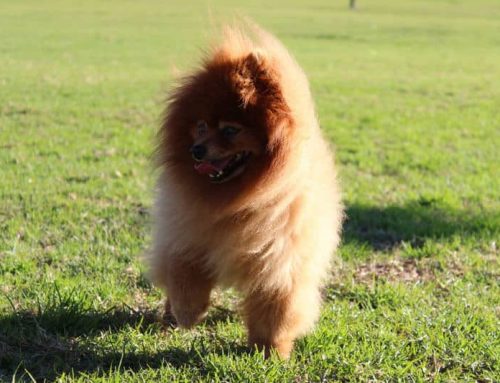
Leave A Comment